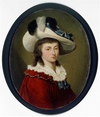FEARMAN, ROBERT CALVER, meat packer; b. 5 June 1858 in Hamilton, Upper Canada, second son of Frederick William Fearman* and Elizabeth Holbrook; m. there 27 May 1885 Frances Sarah French Lister; they had no children; d. there 8 Aug. 1922.
Robert Calver Fearman lived his life according to the examples set by his redoubtable father, founder of the meat-packing firm F. W. Fearman and Company Limited. He was educated in Hamilton’s public schools and collegiate and then at the Dundas Wesleyan Boys’ Institute. Upon graduation, he set to work in the family business as its secretary-treasurer; in January 1899 he and his brothers Frederick Chester, Henry Holbrook, and Frank Dingwall joined their father in incorporating the company. A cautious beginning in curing hams and bacon and rendering lard had blossomed by that time into a concern that employed approximately 110 workers and generated an output worth over $1 million per year. Its famous Star brand of hams and bacon were shipped across Canada and to France, the West Indies, the United States, and Great Britain, where two-thirds of the company’s product was consumed.
F. W. Fearman’s demise in 1906 elevated his eldest son, Chester, to the presidency. Unfortunately, times had changed since the firm’s peak around the turn of the century and the company now faced circumstances that threatened its fiscal viability. The buyout of the interests of four siblings weakened it, but World War I dealt the most crippling blow. To cope with inflation, it was forced to borrow from the Bank of Hamilton. Revenue from Britain and France shrank, products often spoiled on the way overseas, and renovations made necessary by new government regulations on packing houses were costly.
When Chester died of a stroke in 1918, Robert confronted the unenviable task of trying to put the firm back on its feet. He did not prove equal to the challenge. Post-war inflation and depression made debt reduction impossible without outside finance. Accordingly, in 1920 Fearman called on Ernest Jay Howson of the Toronto accounting and manufacturing specialists Thorne, Mulholland, Howson, and McPherson. The “lack of sufficient capital and the extraordinary business conditions” since 1914 compelled him to consider admitting others to the family concern. Such a move, he hoped, would allow reorganization. The public, the Hamilton Spectator intoned, would be “pleased to know that Hamilton is not to lose this old-established industry.” It continued to struggle, however, and in 1922 the Bank of Hamilton forced it into bankruptcy. (It would nonetheless recover and operate under the controlling interest of the family until 1934.) Robert’s efforts had proved unavailing in the wake of the upheavals of the modern era.
In his personal life, as in business, Fearman’s desire to emulate and perhaps please his larger-than-life sire was clear. F. W. Fearman had not confined his entrepreneurial activities to the meat-packing industry, and neither did Robert, who served for many years as president of Armstrong Cartage of Hamilton. Like his father, he was a Methodist and was active in Freemasonry, as a member of the Barton and Murton lodges and treasurer of the Tuscan Lodge. Fearman Sr had been a zealous advocate of public education and libraries. Robert loyally adopted these interests, serving on the board of education in 1914-16 and devoting a great deal of time to library boards and committees. In politics, he too supported the Conservatives for their policy of protection for Canadian industries. His wife was a daughter of Joseph Lister, on whose land F. W. Fearman had opened his first shop. For many years the couple lived in Ivey Lodge, the impressive stone house built by Fearman Sr. It was here that Robert’s health began to fail. An operation two months before his death failed to restore his vigour, although he continued to take an “active interest in business affairs,” and he died in August 1922. He was eulogized as a civic-minded and public-spirited man of sterling character, and the Spectator joined in: “A shrewd business man, yet ever kindly to those in need, no one ever appealed to him for help in vain.” Fearman went to his grave the epitome of a dutiful, upstanding, and perhaps cowed son of a self-made man, whose success in business was the one aspect of his life that his heir could not emulate.
AO, RG 80-5-0-139, no.12706. Hamilton Public Library, Special Coll. Dept. (Hamilton, Ont.), Scrapbooks, H. F. Gardiner, vol.124; Hamilton Public Library Board, vols.1-2; Herald, vol.L3; Times, vol.L3. UCC-C, Fonds 5/8, 78.004C. Hamilton Herald, 8 Aug. 1922. Hamilton Spectator, 13 April 1920, 8 Aug. 1922. DHB, vol.2. Hamilton Public Library, Industrial Hamilton: a trail to the future, “F. W. Fearman Packing Company Limited”: https://epe.lac-bac.gc.ca/100/205/301/ic/cdc/industrial/fearman.htm (consulted 29 Sept. 2020). Magazine of industry and daily times, Hamilton, Ont. - reviewing historically the industrial and financial interests (souvenir ed., Hamilton, 1910; copy in Hamilton Public Library). J. E. Middleton and Fred Landon, The province of Ontario: a history, 1615-1927 (5v., Toronto, 1927-[28]), 4: 488-89. Prominent men of Canada: a collection of persons distinguished in professional and political life, and in the commerce and industry of Canada, ed. G. M. Adam (Toronto, 1892).
© 2005–2024 University of Toronto/Université Laval
Cite This Article
Angela Graham, “FEARMAN, ROBERT CALVER,” in Dictionary of Canadian Biography, vol. 15, University of Toronto/Université Laval, 2003–, accessed April 16, 2024, http://www.biographi.ca/en/bio/fearman_robert_calver_15E.html.
The citation above shows the format for footnotes and endnotes according to the Chicago manual of style (16th edition). Information to be used in other citation formats:
| Permalink: | http://www.biographi.ca/en/bio/fearman_robert_calver_15E.html |
| Author of Article: | Angela Graham |
| Title of Article: | FEARMAN, ROBERT CALVER |
| Publication Name: | Dictionary of Canadian Biography, vol. 15 |
| Publisher: | University of Toronto/Université Laval |
| Year of publication: | 2005 |
| Year of revision: | 2005 |
| Access Date: | April 16, 2024 |






